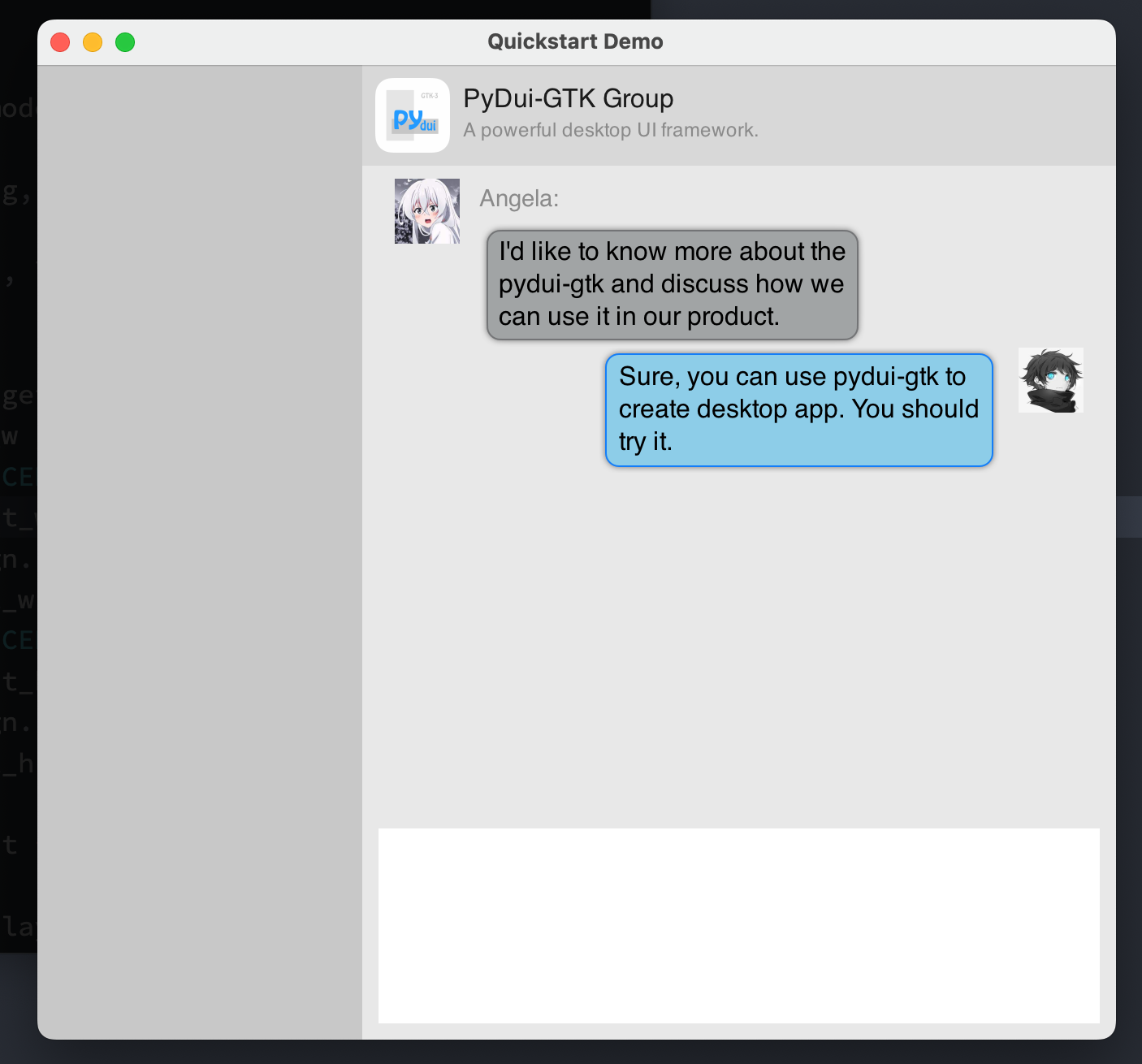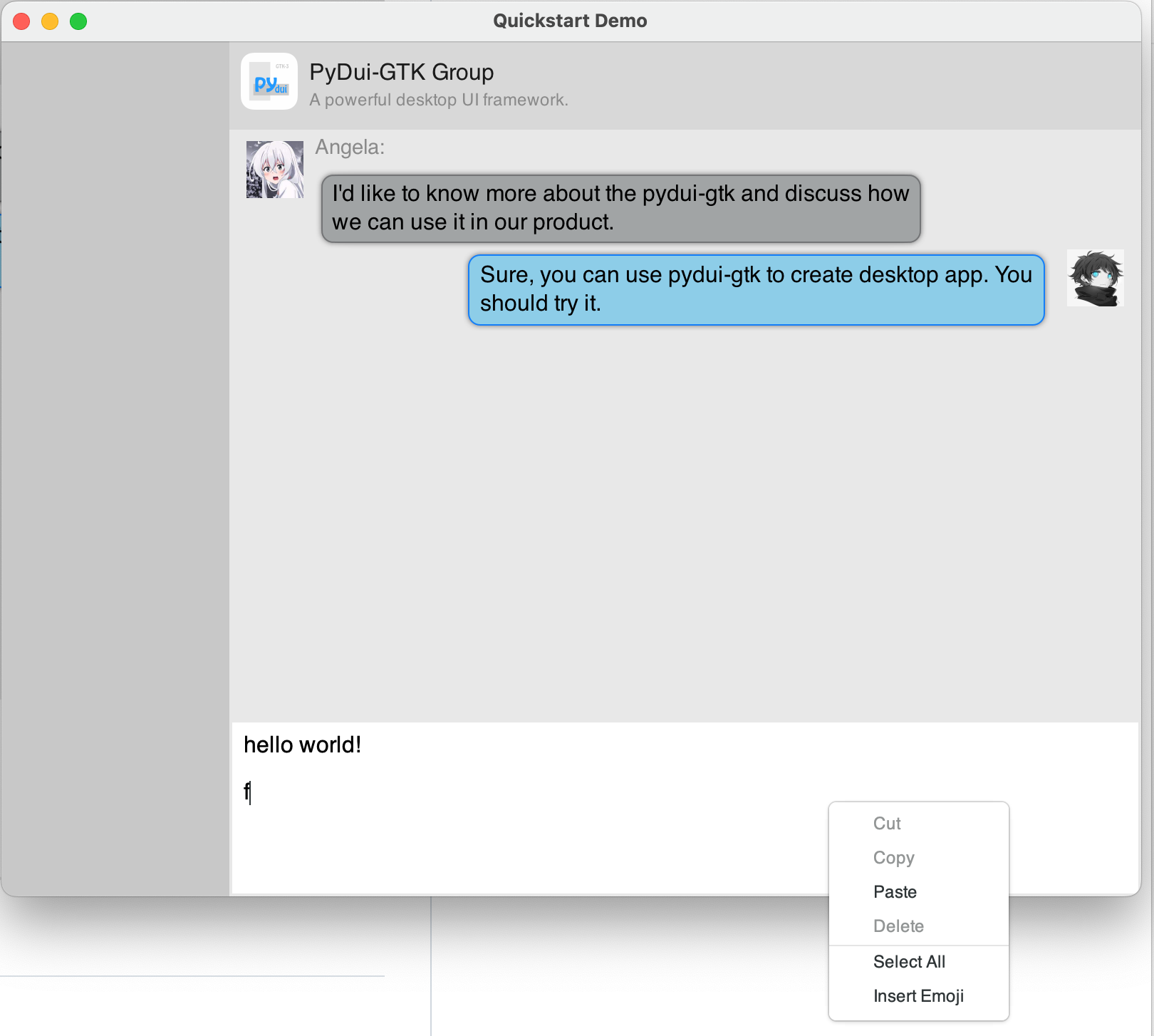Quickstart¶
PyDui Documentation¶
![]()
Introduction¶
PyDui base on GTK-3, PyGObject
PyDui is based on PyGObject/GTK-3, but totally runs on self-drawing canvas. Because GTK-3 widgets are not easy to understand how it works. We are tent to provide an easy API to help developers to build UI applications more quickly and efficiently, putting more focus on the product either than the details of the framework.
Why choose GTK, not QT or any other framework as the low-level module? As GTK is a powerful cross-platform framework, it can run on Windows, MacOSX, and Linux well, and it’s light enough, fewer dependencies mean it can be easy to pack and deploy.
And why use self-drawing instead of GTK’s widget pattern? Even though there is GTK/Glade can quickly build a powerful UI Application. But the Glade is not easy enough to learn. Especially the layout design pattern on GTK is terrible hell for developers and designers.
Sometimes, we need another solution for rapidly building a simple app. I think, on the windows platform, DuiLib is an option because it’s easy to learn. That is the reason we use self-drawing to reimplement all the virtual widgets.
Why not just wrap the DuiLib API ?
This is a good question because DuiLib only works on windows. And the author work on mac. So, this is not for cross-platform purposes, just personal reasons.
Install¶
PyDui require python >= 3.9
Even though it’s easy to downgrade the python version, personal reasons, the author DO NOT WANT TO KEEP ALL THE VERSION WORK!
pip install pydui-gtk
Windows: see the prerequisites below, you must setup the gtk environment first.
Building¶
Prerequisites
miniconda: https://conda.io/projects/conda/en/latest/user-guide/install/index.html
If you are already in python3.9 environment, conda is not needed. but we highly recommend using it to manage the dev env.
Windows:
You can use prebuilt libraries.
pip install --no-binary :all: pygobject-pycairo-prebuilt-libraries-vs2019
Or, you can build your own GTK libraries by following the guide below.
https://github.com/dzhsurf/gtk3-precompiled-libs-win-vs2019
Build Tools: For Windows platform, Microsoft Visual C++ 14.0 or greater is required. Get it with “Microsoft C++ Build Tools”: https://visualstudio.microsoft.com/visual-cpp-build-tools/
Download the prebuilt GTK libraries, then set add bin to the
PATHenvironment, and set theGI_TYPELIB_PATHto thegi_typelibdirectory. Or you can build the GTK libraries your self.Run pip install
pygobjectandpycairopip install --no-binary --force-reinstall :all: pygobject pip install --no-binary --force-reinstall :all: pycairo
MacOSX:
No extra dependencies needed.
Linux: …
No extra dependencies needed. GCC has basically been installed in desktop linux.
Setup and build
# first, checkout the code
# git clone ...
# second, use conda setup environment
conda env create -f conda_env.yaml
conda activate pydui
# local install
pip install -e .
# then you can run the demo
python src/example/demo.py
Code Example¶


import pydui
from pydui import *
from pydui.core.resource_loader import create_default_resource_loader
# config builder here
def get_builder() -> PyDuiBuilder:
builder = PyDuiBuilder()
builder.register_resource_loader(create_default_resource_loader())
return builder
# custom window handler
class DemoHandler(PyDuiWindowHandler):
def on_window_init(self, window: PyDuiWindow):
print(f"on_window_init")
#def handle_click(object):
# print("You clicked!", object)
# bind widget event here
#widget = window.get_widget(widget_id="button")
#widget.connect("clicked", handle_click)
def on_window_destroy(self):
print(f"on_window_destroy")
PyDuiApplication.main_quit()
def main():
print(f"start pydui version: {pydui.__version__}")
window = get_builder().build_window(path="res/main.xml", handler=DemoHandler)
window.show()
PyDuiApplication.main_run()
if __name__ == "__main__":
main()
XML File
<?xml version="1.0" encoding="utf-8"?>
<Window size="664,600" title='Quickstart Demo' min_size="600,400"
default_font="Helvetica" default_fontsize="16">
<HLayout bkcolor="#FFFFFFFF">
<!-- left panel -->
<VLayout bkcolor="#FFC8C8C8" width="200">
</VLayout>
<VLayout halign="CENTER" bkcolor="#FFE8E8E8">
<!-- head -->
<HLayout height="62" bkcolor="FFD8D8D8">
<Picture width="46" image="res/images/logo.png" margin="8,8,8,8" />
<VLayout margin="0,12,0,12">
<Label text="PyDui-GTK Group" halign="START" fontcolor="#FF1A1A1A" />
<Label text="A powerful desktop UI framework." fontsize="12" halign="START" fontcolor="#FF8A8A8A" />
</VLayout>
</HLayout>
<!-- body -->
<VLayout padding="8,8,8,8">
<HLayout valign="START" margin="12,0,12,0" autofit="true" fitrule="h">
<Picture width="40" height="40" image="res/images/avatar-2.jpeg" />
<VLayout halign="START" margin="12,0,122,0" autofit="true" fitrule="h" >
<Label text="Angela:" autofit="true"
fontsize="14" fontcolor="#FF8A8A8A" valign="START" halign="START" />
<Label text="I'd like to know more about the pydui-gtk and discuss how we can use it in our product." margin="0,8,0,0"
autofit="true" autofit_padding="12,8,12,8"
corner="12,12,12,12"
bkimage="res/images/common_button_disable.png"
/>
</VLayout>
</HLayout>
<HLayout valign="START" margin="12,0,12,0" autofit="true" fitrule="h">
<Control />
<Label text="Sure, you can use pydui-gtk to create desktop app. You should try it."
margin="122,0,12,0"
autofit="true" autofit_padding="12,8,12,8"
corner="12,12,12,12"
bkimage="res/images/common_button_normal.png"
/>
<Picture width="40" height="40" image="res/images/avatar-1.jpeg" />
</HLayout>
<!-- bottom bar -->
<Control />
<Edit name="input_edit" bkcolor="#FFFFFFFF" height="120" margin="2,2,2,2" />
</VLayout>
</VLayout>
</HLayout>
</Window>
Support YogaLayout¶
Congratulations! Now you can use YogaLayout in PyDui-GTK!!!
More details about YogaLayout: https://yogalayout.com/docs/
Base on YogaLayout Python binding library - Poga. https://github.com/dzhsurf/poga
<?xml version="1.0" encoding="utf-8"?>
<Window size="800,600" title='Quickstart Demo' min_size="600,400"
default_font="Helvetica" default_fontsize="16">
<PGLayout
bkcolor="#FFEFEFEF"
align_content="stretch"
align_items="stretch"
flex_direction="row"
flex_wrap="nowrap"
>
<!-- left -->
<PGLayout bkcolor="#FFC8C8C8"
width_percent="20"
flex_grow="0"
>
</PGLayout>
<!-- right -->
<PGLayout bkcolor="#FFE8E8E8"
width_percent="80"
flex_direction="column"
align_content="stretch"
align_items="stretch"
flex_wrap="nowrap"
>
<!-- head: Use PGLayout -->
<PGLayout bkcolor="FFD8D8D8"
flex_direction="row"
height="62"
>
<Picture width="40" height="40" image="res/images/logo.png" margin="8,8,8,8" />
<PGLayout margin="0,12"
flex_direction="column"
flex_grow="0" >
<Label text="PyDui-GTK Group" autofit="true" halign="start" fontcolor="#FF1A1A1A" />
<Label text="A powerful desktop UI framework." autofit="true" fontsize="12" halign="start" fontcolor="#FF8A8A8A" />
</PGLayout>
</PGLayout>
<!-- body area: Use PGLayout -->
<PGLayout
flex_direction="column"
flex_grow="1"
align_content="stretch"
align_items="stretch"
>
<!-- Item use HLayout in PGLayout -->
<HLayout valign="start" margin="12,0,12,0" autofit="true" fitrule="h">
<Picture width="40" height="40" image="res/images/avatar-2.jpeg" margin="0,8,0,8" />
<VLayout halign="start" margin="8,0,122,0" autofit="true" fitrule="h" >
<Label text="Angela:" autofit="true"
fontsize="14" fontcolor="#FF8A8A8A" valign="start" halign="start" />
<Label text="I'd like to know more about the pydui-gtk and discuss how we can use it in our product." margin="0,8,0,0"
autofit="true" autofit_padding="12,8,12,8"
corner="12,12,12,12"
bkimage="res/images/common_button_disable.png"
/>
</VLayout>
</HLayout>
<HLayout valign="start" margin="12,0,12,0" autofit="true" fitrule="h">
<Control />
<Label text="Sure, you can use pydui-gtk to create desktop app. You should try it."
margin="122,0,12,0"
autofit="true" autofit_padding="12,8,12,8"
corner="12,12,12,12"
bkimage="res/images/common_button_normal.png"
/>
<Picture width="40" height="40" image="res/images/avatar-1.jpeg" />
</HLayout>
<PGLayout flex_grow="1" >
</PGLayout>
<!-- bottom bar -->
<Edit name="input_edit" bkcolor="#FFFFFFFF" height="120" margin="2,2,2,2" />
</PGLayout>
</PGLayout>
</PGLayout>
</Window>

Internal Layout Engine¶
TODO: …
Architecture¶

Development¶
In the early stage, performance optimization, resource leakage issue, text rendering quality, and correctness issue are not the primary tasks. The first task is to complete the essential module function.
Core
Builder, Render, ResourceLoader, EventDispatcher
Layout
HLayout, VLayout, PGLayout, ScrolledLayout
Widgets
Label, Button, Picture, Edit, TableView, FlowListView, Menu, Toast
Deployment
Resource packer
Application builder
Special Features
Text selection
Drag&Drop
Model Window
Intl
RichText
Window Shadow
Planning: Web Platform Support¶
In the future, I want to add Web platform support on pydui. It is technically possible. Use js-worker to run python code in the browser background thread to handle the framework logic. Such as use pyodide(https://pyodide.org/en/stable/usage/quickstart.html) . Implement the text measure functions RenderAPIs on the web platform instead of cairo on the desktop. Implement yoga-js builder for building the UI from the layout code.
Development progress¶
There’s much work to do…
Builder:
[ Window, Label, Button, Edit, Picture, HLayout, VLayout, PGLayout, ScrolledLayout, … ] - finish
StyleManager - planning
ResourceLoader:
DefaultResourceLoader - finish
FileResourceLoader - pending
ResourceLoaderCache - pending
lrucache
ArchiverResourceLoader - planning
Render:
DrawRectangle - finish
DrawImage - finish
DrawText - finish
Hi-DPI support - almost done
Draw area boundary protection - finish
Layout:
HLayout - finish
VLayout - finish
PGLayout - finish
ScrolledLayout - finish
Fixed widget - finish
Widget:
Widget base - finish
Label - finish
Button - finish
Edit - 30%, processing
Input limit (num, length…)
Focus event (Widget focus manager)
Key Event
Text selection (Label)
Drag&Drop
Picture - 0%, pending
ListView - 0%, pending
FlowListView - 0%, not started
Menu - 0%, not started
Benchmarks¶
TODO
…
Testing¶
TODO
…
Reference¶
YogaLayout: https://yogalayout.com/docs
Python Gtk-3 Tutorial: https://python-gtk-3-tutorial.readthedocs.io/en/latest/index.html
Python Gtk-3: https://lazka.github.io/pgi-docs/Gtk-3.0/index.html
Python Gdk-3: https://lazka.github.io/pgi-docs/Gdk-3.0/index.html
Python GdkPixbuf: https://lazka.github.io/pgi-docs/GdkPixbuf-2.0/index.html
Python Pango: https://lazka.github.io/pgi-docs/Pango-1.0/index.html
Pycairo: https://pycairo.readthedocs.io/en/latest/index.html
PyGObject: https://pygobject.readthedocs.io/en/latest/index.html
Python PangoCairo: https://lazka.github.io/pgi-docs/PangoCairo-1.0/index.html
Gtk-3: https://docs.gtk.org/gtk3/index.html
Pango: https://docs.gtk.org/Pango/index.html
GdkPixbuf: https://docs.gtk.org/gdk-pixbuf/index.html
PangoCairo: https://docs.gtk.org/PangoCairo/
Gtk pgi Symbol Mapping: https://lazka.github.io/pgi-docs/Gtk-3.0/mapping.html
Gdk pgi Symbol Mapping: https://lazka.github.io/pgi-docs/Gdk-3.0/mapping.html
